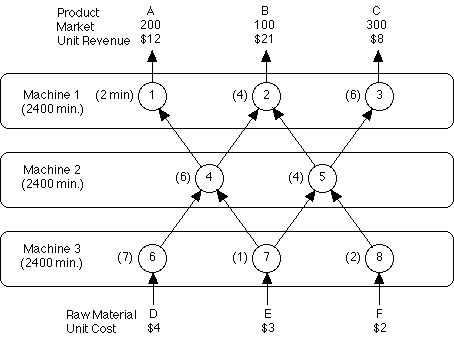| The figure below describes a production
process that makes three products, A, B and C. The numbers at
the top of the figure provides the maximum sales and unit revenues
for the three products. The numbers at the bottom indicate the
raw materials used and the unit costs of the raw materials.
The network structure shows the processing requirements for
the products. The nodes represent operations the products must
pass through and the arcs represent the inputs to the operations.
Product A requires one unit from operation 1. Product B requires
one unit from operation 2. Product C requires one unit from
operation 3.
The product at operation 1 is made from one unit passing out
of operation 4. The product at operation 2 is made from one
unit each of the products passing out of operations 4
and 5. The product at operation 3 is made from one unit passing
out of operation 5.
A unit at operation 4 is made from one unit each from operations
6 and 7. A unit at operation 5 is made from one unit each from
operations 7 and 8.
Finally, operation 6 requires one unit of raw material D. Operation
7 requires one unit of raw material E. Operation 8 requires
one unit of raw material F.
The numbers adjacent to the nodes are the operation times
in minutes. The operations use time on Machine 1, Machine 2
and Machine 3. Each machine has a weekly capacity of 2400 minutes.
The products share the capacities of the machines. For example,
if 100 units of each product were produced, 1200 minutes would
be used on machine 1. Note that product B uses 10 minutes of
machine 2 because both operations 4 and 5 are needed for one
unit of B.

Use process flow analysis to model this problem. Create three
processes, one to model each product. Using the Economic Analysis
button, create the Project worksheet. Enter the economic data.
Create an LP model with using a button on the Project worksheet.
Use the LP model to find the optimum product mix for the three
products. Identify the bottleneck machines.
|

